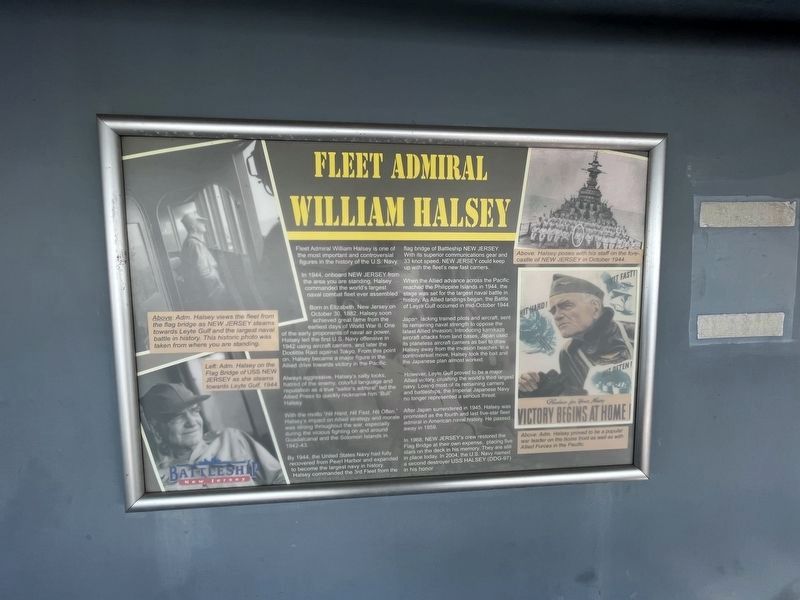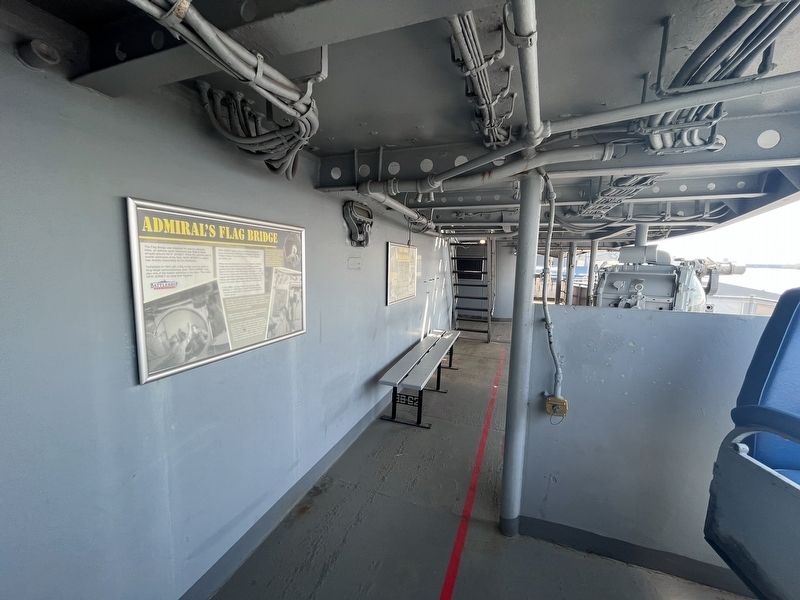Central Waterfront in Camden in Camden County, New Jersey — The American Northeast (Mid-Atlantic)
Fleet Admiral William Halsey
Battleship New Jersey
Fleet Admiral William Halsey is one of the most important and controversial figures in the history of the U.S. Navy.
In 1944, onboard New Jersey from the area you are standing, Halsey commanded the world's largest naval combat fleet ever assembled.
Born in Elizabeth, New Jersey on October 30, 1882. Halsey soon achieved great fame from the earliest days of World War II. One of the early proponents of naval air power, Halsey led the first U.S. Navy offensive in 1942 using aircraft carriers, and later the Doolittle Raid against Tokyo. From this point on, Halsey became a major figure in the Allied drive towards victory in the Pacific.
Always aggressive, Halsey's salty looks, hatred of the enemy, colorful language and reputation as a true "sailor's admiral" led the Allied Press to quickly nickname him "Bull" Halsey.
With the motto "Hit Hard, Hit Fast, Hit Often," Halsey's impact on Allied strategy and morale was strong throughout the war, especially during the vicious fighting on and around Guadalcanal and the Solomon Islands in 1942-43.
When the Allied advance across the Pacific reached the Philippine Islands in 1944, the stage was set for the largest naval battle in history. As Allied landings began, the Battle of Leyte Gulf occurred in mid-October 1944.
Japan, lacking trained pilots and aircraft, sent its remaining naval strength to oppose the latest Allied invasion. Introducing kamikaze aircraft attacks from land bases, Japan used its planeless aircraft carriers as bait to draw Halsey away from the invasion beaches. In a controversial move, Halsey took the bait and the Japanese plan almost worked.
However, Leyte Gulf proved to be a major Allied victory, crushing the world's third largest navy. Losing most of its remaining carriers and battleships, the Imperial Japanese Navy no longer represented a serious threat.
After Japan surrendered in 1945, Halsey was promoted as the fourth and last fie-star fleet admiral in American naval history. He passed away in 1959.
In 1968, New Jersey's crew restored the Flag Bridge at their own expense, placing five stars on the deck in his memory. They are still in place today. In 2004, the U.S. Navy named a second destroyer USS Halsey (DDG-97) in his honor.
[Captions:]
Above: Adm. Halsey views
Left: Adm. Halsey on the Flag Bridge of USS New Jersey as she steams towards Leyte Gulf, 1944.
Above: Halsey poses with his staff on the forecastle of New Jersey in October 1944.
Above: Adm. Halsey proved to be a popular war leader on the home front as well as Allied Forces in the Pacific.
Erected by Battleship New Jersey.
Topics. This historical marker is listed in these topic lists: Air & Space • War, World II • Waterways & Vessels. A significant historical date for this entry is October 30, 1882.
Location. 39° 56.376′ N, 75° 7.992′ W. Marker is in Camden, New Jersey, in Camden County. It is in Central Waterfront. Marker can be reached from Clinton Street west of South Delaware Avenue, on the right when traveling south. The marker is on board the USS New Jersey. Touch for map. Marker is at or near this postal address: 100 Clinton St, Camden NJ 08103, United States of America. Touch for directions.
Other nearby markers. At least 8 other markers are within walking distance of this marker. Admiral's Flag Bridge (here, next to this marker); 04 Level Navigation Bridge (here, next to this marker); Aiming the Secondary Guns (here, next to this marker); Close-In Weapons System (a few steps from this marker); Aiming the Big Guns (a few steps from this marker); a different marker also named Admiral's Flag Bridge (a few steps from this marker); Admirals and the Flag Cabin (a few steps from this marker); Mark 36 Super Rapid Bloom Offboard Chaff (SRBOC) (a few steps from this marker). Touch for a list and map of all markers in Camden.
Credits. This page was last revised on April 24, 2023. It was originally submitted on April 24, 2023, by Devry Becker Jones of Washington, District of Columbia. This page has been viewed 75 times since then and 20 times this year. Photos: 1, 2. submitted on April 24, 2023, by Devry Becker Jones of Washington, District of Columbia.

